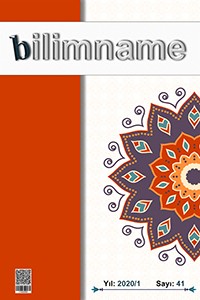Öz
Kısa bir tanımla bir sanatçının tek eseri üzerine yazılan sözlüğe o eserin “metin sözlüğü”; o sanatçıya ait tüm eserlerin sözvarlığının bir araya getirildiği sözlüğe de “sanatçı sözlüğü” denebilir. Bu çalışmada amacımız bir “metin sözlüğü”nün nasıl vücuda getirileceği konusunda yol göstermektir. Bir araştırmacının edebî değeri yüksek ve mana açısından girift bir eser üzerinde çalışıp isabetli değerlendirmeler yapabilmesi için önce eseri kendisi iyi anlamalı ve tahlil etmelidir. Bunun için araştırmacının bilhassa dîvân edebiyatında öncelikle kendisi için o esere ait bir sözlük çıkarması ve bu sözlüğü esere dahil ederek okuyucuya yol göstermesi gerekmektedir.
Anahtar Kelimeler
Türk İslâm Edebiyatı sözlük metin sözlüğü sanatçı sözlüğü metin sözlüğü hazırlamak sözlükbilim
Kaynakça
- AKSAN, D. (2003). Her Yönüyle Dil Ana Çizgileriyle Dilbilim. Ankara: TDK Yay.
- ATATÜRK KÜLTÜR, DİL VE TARİH YÜKSEK KURUMU. (1995). Tarama Sözlüğü (3. Baskı., C. 1-8). Ankara: TDK Yay.
- BİLTEKİN, H. (2017). Bir Eser Sözlüğü: Lugât-i Siyer-i Veysî. III. Uluslararası Sözlükbilimi Sempozyumu Bildiri Kitabı içinde . Eskişehir: Eskişehir Osmangazi Üniversitesi Basımevi.
- BİNGÖLÇE, F. (2011). Örnekleriyle Osmanlı Argosu Sözlüğü. Ankara: AltÜst Yay.
- ÇALIŞLAR, A. (1994). Shakespeare Sözlüğü. İstanbul: Mitos Boyut Yay.
- ÇATIKKAŞ, M. A. (2009). Şiirimizin Beyitler ve Mısralar Sözlüğü. (K. Yıldız, Ed.) (C. 1-3). Sütun Yayınları.
- ÇETİNKAYA, Ü. (2015). Şiirde Anlam Kapalılığı Bağlamında Fehim-i Kadim’in Bir Gazeli Üzerine Değerlendirmeler. Gazi Türkiyat Türkoloji Araştırmaları Dergisi, 2015(16), 71-96.
- DANKOFF, R. (2004). Evliya Çelebi Seyahatnamesi Okuma Sözlüğü. (S. Tezcan, Çev.). İstanbul: Türk Dilleri Araştırmaları Dizisi: 37.
- DİLÇİN, C. (1983). Yeni Tarama Sözlüğü. Ankara: TDK Yay.
- DURMUŞ, İ. (2009). Sözlük. Türkiye Diyanet Vakfı İslâm Ansiklopedisi. Ankara: TDV Yay.
- HO, D. (2015). Notepad++. GNU GPL. https://notepad-plus-plus.org adresinden erişildi.
- LEVEND, A. S. (1984). Divan Edebiyatı Kelimeler ve Remizler; Mamunlar ve Mefhumlar (4. Baskı.). İstanbul: Endereun Kitabevi.
- Microsoft Office 365. (2011). C++, Microsoft. https://products.office.com adresinden erişildi.
- MUHTAR, C. (1993). İki Kur’an Sözlüğü: Luğat-ı Ferişteoğlu ve Luğat-ı Kânûn-ı İlâhî. İstanbul: Marmara Üniversitesi İlahiyat Vakfı Yay.
- NUTKU, Ö. (2008). Shakespeare Sözlüğü. İstanbul: Kabalcı Yay.
- ONAY, A. T. (2019). Açıklamalı Divan Şiiri Sözlüğü Eski Türk Edebiyatında Mazmunlar ve İzah (3. Baskı.). Ankara: Kurgan Edebiyat Yay.
- ÖZ, Y. (1996). Tarih Boyunca Farsça-Türkçe Sözlükler. (Doktora Tezi). https://tez.yok.gov.tr/UlusalTezMerkezi adresinden erişildi.
- ÖZTÜRK, F. (2016). Bâkî Divanı Sözlüğü (C. 1-2). İstanbul: DBY Yay.
- PALA, İ. (2004). Ansiklopedik Dîvân Şiiri Sözlüğü. İstanbul: Kapı Yay.
- PÜSKÜLLÜOĞLU, A. (1974). Yaşar Kemal Sözlüğü. İstanbul: Cem Yay.
- ŞAFAK, S. R. (1971). Ferheng-i şâhnâme. Tahran: Silsile-i İntişârât-ı Encümen-i Âsâr-ı Millî.
- TÖKEL, D. A. (2009). Divan Şiirinin Anlaşılmamasında Sözlüklerin Rolü Nedir? Turkish Studies International Periodical For the Languages, Literature and History of Turkish or Turkic, 4(4), 933-944. doi:http://dx.doi.org/10.7827/TurkishStudies.840
- TULUM, M. (2011). 17. Yüzyıl Türkçesi ve Söz Varlığı. Ankara: TDK Yay.
Öz
Anahtar Kelimeler
Turkish Islamic Literature dictionary text dictionary artist dictionary preparing text dictionary lexicology
Kaynakça
- AKSAN, D. (2003). Her Yönüyle Dil Ana Çizgileriyle Dilbilim. Ankara: TDK Yay.
- ATATÜRK KÜLTÜR, DİL VE TARİH YÜKSEK KURUMU. (1995). Tarama Sözlüğü (3. Baskı., C. 1-8). Ankara: TDK Yay.
- BİLTEKİN, H. (2017). Bir Eser Sözlüğü: Lugât-i Siyer-i Veysî. III. Uluslararası Sözlükbilimi Sempozyumu Bildiri Kitabı içinde . Eskişehir: Eskişehir Osmangazi Üniversitesi Basımevi.
- BİNGÖLÇE, F. (2011). Örnekleriyle Osmanlı Argosu Sözlüğü. Ankara: AltÜst Yay.
- ÇALIŞLAR, A. (1994). Shakespeare Sözlüğü. İstanbul: Mitos Boyut Yay.
- ÇATIKKAŞ, M. A. (2009). Şiirimizin Beyitler ve Mısralar Sözlüğü. (K. Yıldız, Ed.) (C. 1-3). Sütun Yayınları.
- ÇETİNKAYA, Ü. (2015). Şiirde Anlam Kapalılığı Bağlamında Fehim-i Kadim’in Bir Gazeli Üzerine Değerlendirmeler. Gazi Türkiyat Türkoloji Araştırmaları Dergisi, 2015(16), 71-96.
- DANKOFF, R. (2004). Evliya Çelebi Seyahatnamesi Okuma Sözlüğü. (S. Tezcan, Çev.). İstanbul: Türk Dilleri Araştırmaları Dizisi: 37.
- DİLÇİN, C. (1983). Yeni Tarama Sözlüğü. Ankara: TDK Yay.
- DURMUŞ, İ. (2009). Sözlük. Türkiye Diyanet Vakfı İslâm Ansiklopedisi. Ankara: TDV Yay.
- HO, D. (2015). Notepad++. GNU GPL. https://notepad-plus-plus.org adresinden erişildi.
- LEVEND, A. S. (1984). Divan Edebiyatı Kelimeler ve Remizler; Mamunlar ve Mefhumlar (4. Baskı.). İstanbul: Endereun Kitabevi.
- Microsoft Office 365. (2011). C++, Microsoft. https://products.office.com adresinden erişildi.
- MUHTAR, C. (1993). İki Kur’an Sözlüğü: Luğat-ı Ferişteoğlu ve Luğat-ı Kânûn-ı İlâhî. İstanbul: Marmara Üniversitesi İlahiyat Vakfı Yay.
- NUTKU, Ö. (2008). Shakespeare Sözlüğü. İstanbul: Kabalcı Yay.
- ONAY, A. T. (2019). Açıklamalı Divan Şiiri Sözlüğü Eski Türk Edebiyatında Mazmunlar ve İzah (3. Baskı.). Ankara: Kurgan Edebiyat Yay.
- ÖZ, Y. (1996). Tarih Boyunca Farsça-Türkçe Sözlükler. (Doktora Tezi). https://tez.yok.gov.tr/UlusalTezMerkezi adresinden erişildi.
- ÖZTÜRK, F. (2016). Bâkî Divanı Sözlüğü (C. 1-2). İstanbul: DBY Yay.
- PALA, İ. (2004). Ansiklopedik Dîvân Şiiri Sözlüğü. İstanbul: Kapı Yay.
- PÜSKÜLLÜOĞLU, A. (1974). Yaşar Kemal Sözlüğü. İstanbul: Cem Yay.
- ŞAFAK, S. R. (1971). Ferheng-i şâhnâme. Tahran: Silsile-i İntişârât-ı Encümen-i Âsâr-ı Millî.
- TÖKEL, D. A. (2009). Divan Şiirinin Anlaşılmamasında Sözlüklerin Rolü Nedir? Turkish Studies International Periodical For the Languages, Literature and History of Turkish or Turkic, 4(4), 933-944. doi:http://dx.doi.org/10.7827/TurkishStudies.840
- TULUM, M. (2011). 17. Yüzyıl Türkçesi ve Söz Varlığı. Ankara: TDK Yay.
Ayrıntılar
| Birincil Dil | Türkçe |
|---|---|
| Bölüm | Makaleler |
| Yazarlar | |
| Yayımlanma Tarihi | 15 Mayıs 2020 |
| Gönderilme Tarihi | 2 Ocak 2020 |
| Kabul Tarihi | 1 Mayıs 2020 |
| Yayımlandığı Sayı | Yıl 2020 Cilt: 2020 Sayı: 41 |


